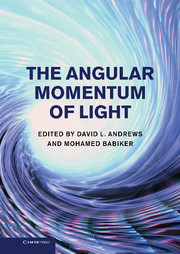Book contents
- Frontmatter
- Contents
- List of contributors
- Preface
- 1 Light beams carrying orbital angular momentum
- 2 Vortex transformations and vortex dynamics in optical fields
- 3 Vector beams in free space
- 4 Optical beams with orbital angular momentum in nonlinear media
- 5 Ray optics, wave optics and quantum mechanics
- 6 Quantum formulation of angle and orbital angular momentum
- 7 Dynamical rotational frequency shift
- 8 Spin-orbit interactions of light in isotropic media
- 9 Quantum electrodynamics, angular momentum and chirality
- 10 Trapping of charged particles by Bessel beams
- 11 Theory of atoms in twisted light
- 12 An experimentalist's introduction to orbital angular momentum for quantum optics
- 13 Measurement of light's orbital angular momentum
- 14 Efficient generation of optical twisters using helico-conical beams
- 15 Self-similar modes of coherent diffusion with orbital angular momentum
- 16 Quantum entanglement of orbital angular momentum
- Index
- References
12 - An experimentalist's introduction to orbital angular momentum for quantum optics
Published online by Cambridge University Press: 05 December 2012
- Frontmatter
- Contents
- List of contributors
- Preface
- 1 Light beams carrying orbital angular momentum
- 2 Vortex transformations and vortex dynamics in optical fields
- 3 Vector beams in free space
- 4 Optical beams with orbital angular momentum in nonlinear media
- 5 Ray optics, wave optics and quantum mechanics
- 6 Quantum formulation of angle and orbital angular momentum
- 7 Dynamical rotational frequency shift
- 8 Spin-orbit interactions of light in isotropic media
- 9 Quantum electrodynamics, angular momentum and chirality
- 10 Trapping of charged particles by Bessel beams
- 11 Theory of atoms in twisted light
- 12 An experimentalist's introduction to orbital angular momentum for quantum optics
- 13 Measurement of light's orbital angular momentum
- 14 Efficient generation of optical twisters using helico-conical beams
- 15 Self-similar modes of coherent diffusion with orbital angular momentum
- 16 Quantum entanglement of orbital angular momentum
- Index
- References
Summary
Introduction
Although the orbital angular momentum (OAM) of light is often quantified in terms of ℓℏ per photon, one should recognise that this result can be derived directly from Maxwell's equations and is most certainly not an exclusively quantum property. Following the recognition of optical OAM in 1992 [1], the immediate thrust of experimental work was to observe OAM transfer to microscopic objects. These exciting experiments by Rubinsztein- Dunlop [2, 3] and others established that the predicted angular momentum was truly mechanical, but did not provide insight on OAM at the level of single photons. Laguerre- Gaussian modes were identified as being a natural basis set for describing beams with OAM, where their phase terms describe the helical phasefronts corresponding to an OAM of ℓℏ per photon.
The polarisation of light has played an important historical role in the experimental investigation of quantum entanglement, quantum gate operations and quantum cryptography. A potential advantage of OAM is that it resides in a higher-dimensional state space which, as follows from the theory, is infinite-dimensional. One of the experimental challenges is to access a large number of these dimensions. In quantum communication, the most obvious advantage of high n-dimensional systems is the increased bandwidth [4], but qunits also lead to stronger security [5, 6]. An increase in the number of entangled quantum modes has also been shown to improve measures of nonlocality [7], to allow quantum computation with better fault tolerance [8] and to simplify quantum logic structures [9].
- Type
- Chapter
- Information
- The Angular Momentum of Light , pp. 314 - 329Publisher: Cambridge University PressPrint publication year: 2012

